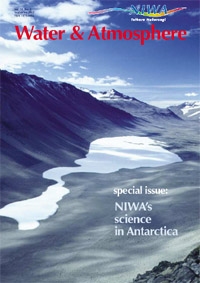
These are the terms printed in bold in articles in this issue. Use your Back button to return to the article.
Anoxic: without oxygen.
Antarctic Cold Reversal: a period between 14,800 and 12,800 years ago when the warming trend since the peak of the last ice age (23,000 years ago) temporarily halted.
Conductivity: a measure of a water sample’s capacity to conduct electricity, often used to approximate the amount of dissolved salts. Units are Seimens (S) per unit length. Conductivity of tap water is typically 50–150 µS/cm (where µS = S/1000,000).
Cyanobacteria: microscopic plants (bluegreen algae) that photosynthesise but are more closely related to bacteria than to other plants. They often contain blue-green pigments and were probably one of the earliest forms of life on Earth.
Diatoms: single-celled algae with ornamented silica cell walls. Diatoms are very common in both marine and fresh waters.
Fast ice: sea ice attached to the shore, generally in the position where it first formed.
Katabatic: describes a wind directed down a slope, caused by downhill drainage of cooler, dense mountain air. Katabatic winds in Antarctica tend to flow from the central ice dome down valleys and can be very strong.
Nematodes: small, unsegmented worms common in soils and sediments.
Nototheniid: belonging to the Nototheniidae, a family of typical spinyfinned fishes. Nototheniids have anti-freeze properties in their blood and include most of the fish inhabiting the ocean surrounding Antarctica.
Pack ice: sea ice made up of a floating mosaic of plates of ice that is free to drift with currents, tides and wind (cf. fast ice).
Pelagic: living within the upper part of the ocean, away from the shore.
Precambrian: the oldest geological era, comprising all geological time before about 600 million years ago. The last era of the Precambrian saw the emergence of organised life in the form of stromatolites (layered microbial communities).
Primary production: the conversion of solar energy into chemical energy through photosynthesis in plants. Carbon dioxide and water are converted into organic material.
Production: the accumulation of biomass by plants or animals before any losses from, for example, predation, migration.
Sink: refers to a location where chemicals or nutrients eventually end up.
Snowball Earth: the theory that the Earth was completely frozen over for 10 million years and then warmed rapidly about 600 million ago as a result of warming from CO2 entering the atmosphere from volcanoes. Some scientists believe that this rapid warming created the conditions needed for the evolution of complex life on Earth.
Stable isotope: isotopes of an element have the same atomic number, but different atomic mass. Some isotopes undergo spontaneous radioactive decay; stable isotopes do not decay.
Stratosphere: the region of the atmosphere between about 10 and 50 km above the troposphere.
Sublimation: the process in which solids transform directly to a gas or vapour without going through a liquid phase.
Tardigrades: tiny, but cute, aquatic invertebrates with a segmented body and four pairs of legs; also known as water bears.
Trace gases: gases found in minute quantities in the atmosphere.
Troposphere: the part of the atmosphere closest to the Earth’s surface, extending up about 10 km. The temperature in the troposphere decreases steadily with increasing altitude.
Water mass: a more or less isolated body of water defined by its temperature and salinity characteristics and created by surface processes at a specific location. Isolation can be by land masses or more frequently by strong density gradients that retard mixing. Water masses are modified as they move and can eventually mix with other water masses.
